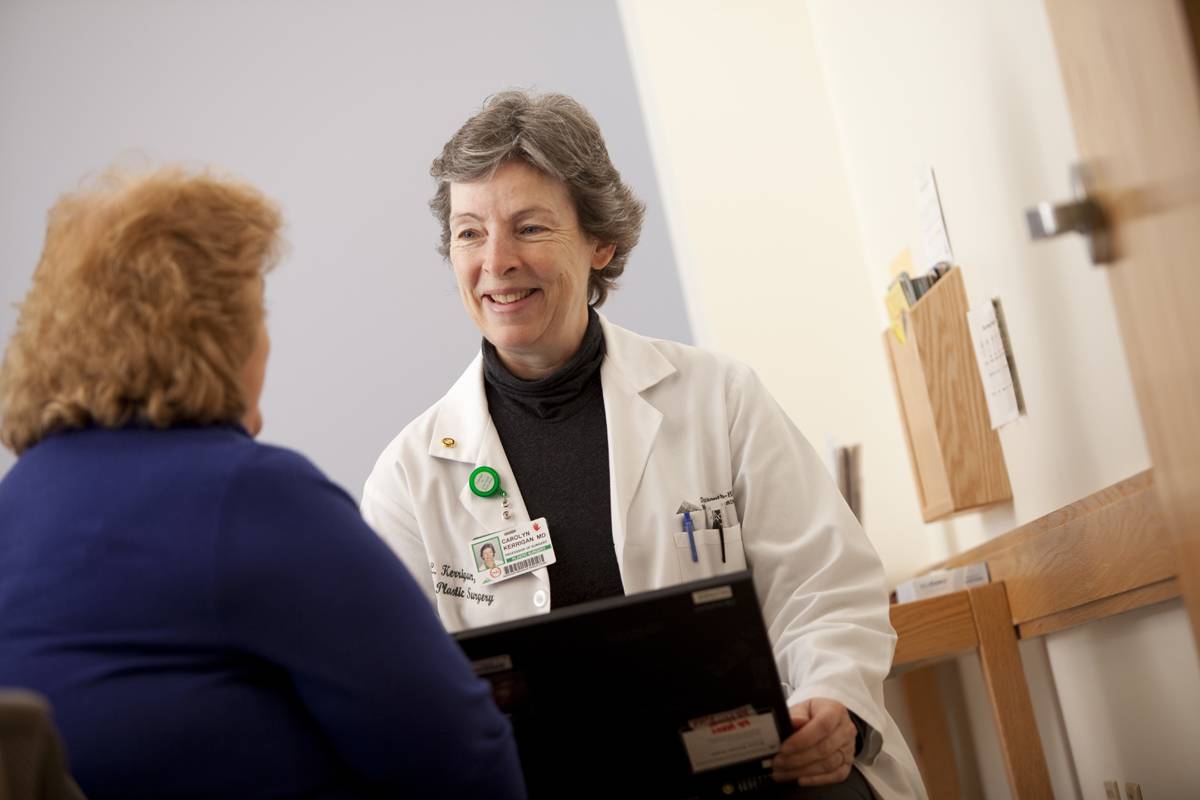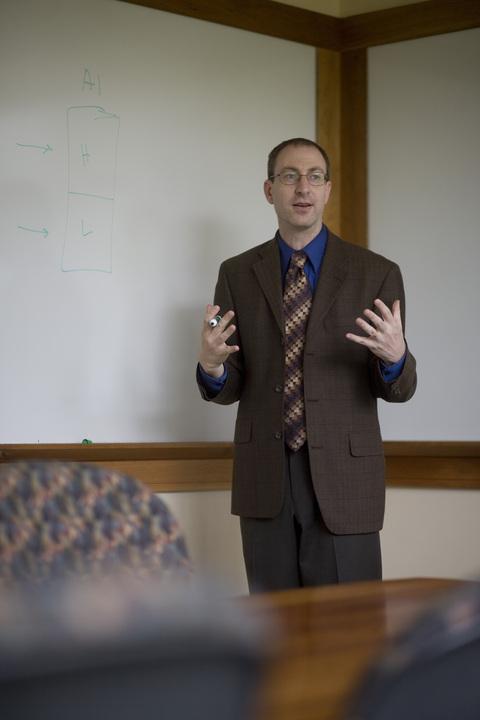Tuck and TDI Welcome First Master of Health Care Delivery Science Students
Forty-seven healthcare professionals begin a unique degree aimed at increasing the quality and lowering the costs of healthcare.

One of the great mysteries of our time is why the United States spends 50 percent more on healthcare than any other country, yet is ranked 37th among nations in healthcare system performance. On July 5, 47 healthcare professionals—doctors, nurses, and senior administrators—will arrive in Hanover to embark on a unique search for clues to this conundrum of value. They are students in the first class of the Master of Health Care Delivery Science program, a collaboration between the Tuck School of Business and The Dartmouth Institute for Health Policy and Clinical Practice (TDI).
Healthcare delivery science is a new field of study that joins the three pillars of medicine—scientific research, clinical practice, and evaluation science—to determine how best to deliver medical intervention to everyone who needs it. This is not an easy task. The medical community has identified 13,000 potential diagnoses, which doctors treat with more than 6,000 drugs and 4,000 procedures. The system that administers this care is highly fragmented, with wide variations in utilization, costs, and outcomes between geographic regions. And it is dangerously expensive. The U.S. currently funnels 17 percent of its gross domestic product to healthcare, and that number is expected to hit 20 percent very soon. By all accounts, the system is unsustainable and in need of serious reform.
Into this fray comes The Dartmouth Center for Health Care Delivery Science. Founded last spring through a $35-million anonymous donation, and led by Dartmouth College president Dr. Jim Yong Kim, Dartmouth-Hitchcock Medical Center co-president Dr. James N. Weinstein, and Dartmouth College provost Carol Folt, it’s an effort to leverage the resources of Dartmouth’s undergraduate and graduate programs to increase the quality of healthcare while decreasing its costs.
This degree is the only true integration of clinical research and data with a comprehensive business management curriculum.
The executive director of the Center is Dr. Albert G. Mulley, Jr. D’70, an international leader in the science and application of shared decision-making and other forms of collaboration between doctors and patients. His charge is to marry Dartmouth’s existing healthcare innovations—such as the Dartmouth Atlas of Health Care, TDI, the Spine Center, and the Center for Shared Decision Making—with the knowledge that exists in the Arts and Sciences, and at Tuck, the Thayer School of Engineering, and Dartmouth Medical School (DMS).
The master’s degree is the first substantial step in the center’s mission, and the first program of its kind. Some MBA degrees have healthcare tracks, and a variety of health policy schools offer management training, but this degree is the only true integration of clinical research and data with a comprehensive business management curriculum. The core classes, many of which are team-taught by professors from Tuck and TDI, cover finance and accounting, marketing, healthcare operations, health economics and policy, strategy for healthcare organizations, and management of organization change, among other topics. There’s also significant instruction in personal leadership, and each student must join a team and participate in project that solves a real problem for a client.
The format of the program is known as hybrid pedagogy; it lasts 18 months and features four residential periods of roughly one week each. During the residencies, students will begin a new set of classes and finish the block of courses begun in the previous residency. For example, during the first residency, students will take an introductory class called the Science of Healthcare Delivery—taught by Dr. Kim; Dr. Jack Wennberg, co-founder of the Dartmouth Atlas; Dr. Weinstein; Dr. Eliot S. Fisher, a professor of medicine at DMS; Tuck senior associate dean Bob Hansen; and TDI faculty member Eric Wadsworth D’74—and kick off Finance Essentials for Leaders in Healthcare Delivery; Leveraging Data to Inform Decision Making; and Clinical Microsystems. They’ll continue those courses via distance learning and return to campus in January to wrap them up and begin another set.
The distance learning, which takes place through Adobe Connect and a specially tailored web portal built on the Blackboard infrastructure, consists of live sessions with faculty, along with videos and other material that students can review at any time. The idea is that students can keep their day jobs, yet engage in substantive learning for short, but intense sessions. “We want this program to deliver a learning experience commensurate with what Tuck has always stood for,” Hansen explains. “The challenge is to translate the beauty of what we do here on campus—high quality, highly personalized instruction—to a distance program.”
They key to this approach, says Hansen, is a robust and student-oriented staff. Katy Milligan D’90, T’07 is a lecturer at Tuck and the program director for the master’s degree. She’s been working at Tuck’s Healthcare Initiative since 2007, as both a research associate and a designer of the curriculum. In her capacity as director, Milligan is co-teaching the Action Learning Project with Dr. Dale Vidal, a surgeon and the director of the Center for Informed Choice at TDI. The Action Learning Project features coursework on team building and organizational behavior, but its main role is to challenge students to put their new learning to use in a healthcare setting.
During the first six months, students complete their project proposals and pitch them to Milligan and Vidal. Milligan expects about 30 proposals, but says that only 10 will be allowed to move forward. Students rank the projects according to their preferences and then assemble in teams of five or six. Some teams will come from one healthcare organization; others will have members from different organizations. During the non-residential periods, teams will meet with faculty online every two weeks to discuss problems and strategize. In the final six months, ideally, every project will have been implemented long enough so that the teams can present preliminary assessments on their goals. “Not only do they have to prove that this project will improve peoples’ health,” Milligan says, “but they also have to say why it’s cost effective.”
Equally integral to the program are the three curriculum specialists, all with Ph.Ds., who are liaisons between faculty and students and help meld the disciplines of clinical policy and business. One example is David Baker, an assistant professor in the Center for Leadership and Improvement at TDI. He has an MBA from the Yale School of Management and a doctorate from the Johns Hopkins Bloomberg School of Public Health. Before joining TDI, Baker was the director of quality improvement at Johns Hopkins Hospital in Baltimore, and worked with physicians, nurses, and administrators on improving patient outcomes and hospital operations. “The thinking behind my role here,” he says, “is to not just put together a compilation of business school courses and public health courses, but rather have a more cohesive, integrated program.”
Baker influences the degree in three ways: by designing courses with Tuck and TDI faculty, translating the content into an online format that’s digestible by busy professionals, and being a consistent advisor for students curious about the connections between sometimes disparate topics. His background in leadership studies is also relevant, he says, because the “healthcare challenges are so complex, and to make change you need to have the skills to bring people together, understand their strengths, and lead them through it.”

Shumsky adapted his MBA course in subtle but important ways to reach the audience of healthcare workers in the new degree. He emphasized patient safety—a quality component that doesn’t rank highly in other sectors—and distilled the content down to the crucial principles to accommodate the time-pressured students. He and Baker co-wrote a teaching note on process analysis, the concept of breaking down a system into components to understand how they relate to each other, and focused on the flow of patients from intensive care beds to recovery beds. “He’s a guy who focuses on operational improvement,” Shumsky says of Baker, “so we already spoke the same language and used the same ideas. He has a lot more applied knowledge and I have a little more theory.”
People talk about costs, but that's not the most important thing. It turns out that better quality care actually costs less." —Dr. Carolyn Kerrigan, a professor of surgery at TDI and a student in the master's degree program
Dr. Carolyn Kerrigan, a professor of surgery at TDI and a student in the master’s program, has her share of applied knowledge too. She splits her time between teaching, serving on the core measurement unit for population health at TDI, and leading the implementation of electronic medical records and patient-reported outcomes at Dartmouth-Hitchcock. Kerrigan is one of six master’s students from DHMC: three doctors; a nurse and director of perioperative services; an accountant and director of ambulatory services; and Robin Kilfeather-Mackey, the chief financial officer.
“As we look at the healthcare crisis,” Kerrigan says, “we’re more frequently hearing the word ‘value’ as describing what we’re trying to create. And people talk about costs, but that’s not the most important thing. It turns out that better quality care actually costs less.” A central goal for the DHMC team, she says, is to figure out which reforms create that money-saving, high-quality result. But one of the structural barriers, she explains, is that healthcare is funded in way that rewards quantity, not quality. It’s a perverse world where patient complications often equal increased hospital revenue. “You send another bill and get paid more,” she says. “That’s definitely part of what we’ll be wrestling with in the program.”
At the Dartmouth TEDx conference in March, Dr. Mulley crystallized one of the major ambitions of healthcare reform: to ensure that everyone gets the care they need and no less, and the care they want and no more. Within that simple directive is a universe of complexity—an interplay of politics and policy, clinical practice and business management—that seems amenable to the 360-degree analysis fostered in the new degree. That’s what’s so exciting about the program, says Hansen. “We have a real chance to make a big influence on the way care is practiced and the value we get from the healthcare system.”